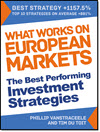If you want a clear, proven way to grow your investments without guesswork, this article is for you. You'll learn how to use a data-driven quant investing model to pick high-potential stocks, diversify smartly with the 2% rule, and protect your portfolio with stop-loss strategies.
Plus, you’ll discover how to avoid emotional pitfalls and over-diversification, so you stay focused on quality over quantity. By following these simple, effective steps, you can build a strong portfolio and capture maximum returns—all without the stress of stock picking.
Estimated Reading Time: 6 minutes
You have also probably wondered how to pick the best stocks to grow your money. With so many options, it can feel overwhelming to decide which companies to buy and which to leave out. But what if you didn’t have to make all those hard choices on your own?
A Proven System You Can Use
What if a proven, data-driven system could help you pick the best stocks to invest in? That's exactly what the Quant Value newsletter does—it provides you with investment ideas based on solid research, not guesswork.
But even with these great ideas in hand, you might still wonder how to make sure you’re capturing the best ones for your portfolio.
This article will show you how to take the best ideas, balance your portfolio, and avoid overloading it.
Why Following a Quant Model Beats Stock Picking
It’s tempting to think you can outsmart the market by picking only the stocks you like or understand. Maybe you feel more comfortable with certain industries or avoid others because of past losses. Everyone has their own biases.
But here's the thing: letting your personal feelings guide your investments can hurt your returns.
With the Quant Value newsletter, you’re given a list of investment ideas selected by a quantitative model.
This model doesn’t care about feelings or trends—it’s built to find the stocks with the best chances of giving you high returns. By trusting the model and following its recommendations, you’ll be able to remove emotions from your decisions and focus on what really works.
The 2% Rule: Limiting Risk While Maximizing Gains
One of the most important rules you can follow in investing is to spread your risk across many different stocks.
The Quant Value newsletter suggests investing no more than 2% of your portfolio in any single idea. This way, if one stock doesn’t perform well, it won’t sink your entire portfolio.
It’s like not putting all your eggs in one basket.
By following the 2% rule, you also make sure you don’t miss out on big winners.
You might be surprised which stocks shoot up in value. For example, Pandora, a struggling Danish jeweller, rose 173%, and who could have predicted that?
By staying diversified, you ensure that you're in the game for those kinds of gains, without putting too much risk on any one stock.
Here are a few other best returns you could have earned:
- Reply SPA +269.2%
- MGI Coutier SA +239.1%
- Montupet SA +315.5%
- Linedata +157.1%
- Delclima +92.4%
- Dart Group +84.1%
- CropEnergies +75.9%
- Groupe Crit +75.2%
- Assystem +82.7%
We are Not Always Right
You have also seen there were a few ideas that have not done well (you know that you cannot win them all) but they have been in the minority.
Balancing Quality with Diversification: Avoid Overloading Your Portfolio
While it's important to diversify, you don’t want to own so many stocks that your gains get diluted.
This is called over-diversification, and it can happen if you try to hold too many stocks at once. The key is to find the right balance—holding enough stocks to spread risk but not so many that you can’t benefit from big winners.
The Quant Value newsletter helps by giving you only a handful of well-researched ideas each month. This helps you focus on quality over quantity. If you stick to the newsletter’s recommendations, you won’t overload your portfolio, but you’ll still have enough diversity to protect yourself from major losses.
Using Stop-Loss Strategies to Protect Your Portfolio
Investing isn’t just about picking winners—it’s also about knowing when to cut your losses.
The Quant Value newsletter uses a stop-loss system that automatically tells you when to sell a stock if it drops too far in price. This helps you avoid emotional decisions, like holding onto a stock just because you don’t want to admit it’s losing money.
With a stop-loss strategy, you can sell underperforming stocks early, keeping your losses small. At the same time, you let your winning stocks keep growing. This way, your portfolio can handle market downturns without taking too many big hits.
You can follow the stop-loss transactions, they are in every newsletter.
The Importance of Sticking to the Model
One of the hardest things about investing is staying disciplined. It's easy to second-guess yourself and tweak your strategy. But if you start picking and choosing from the Quant Value newsletter’s recommendations instead of following the model, research has shown that this will only lower your returns.
The system works best when followed consistently.
The model has been tested and proven to work overtime. Trusting the process, even when some picks don’t look like winners at first, will give you the best chance for success.
The Psychology of Investing: Overcoming Emotional Biases
It’s natural to feel nervous when the market drops or excited when your stocks go up. But these emotions can lead to poor decisions, like selling too soon or holding on to bad investments for too long.
The Quant Value newsletter helps take emotions out of the equation by giving you clear, data-driven recommendations. If you find yourself feeling anxious about a particular stock, remember to step back and look at the bigger picture. Trust in the model, and let the numbers guide you.
Over time, you’ll find it easier to overcome your biases and stick to the plan. Keeping a journal of your thoughts and feelings during market movements can help you see where emotions might be influencing your decisions.
Conclusion: A Simple Yet Powerful Strategy for Maximum Returns
At the end of the day, the simplest and most effective strategy is to trust the Quant Value model, follow the 2% rule, and use stop-losses to protect yourself from big losses.
By doing this, you’ll be able to capture the best ideas from the newsletter and maximize your returns without overloading your portfolio.
Ready to take your investing to the next level?
7 Frequently Asked Questions (FAQs) for Personal Investors
1. How can I trust a quant investing model over my own stock-picking skills?
Quantitative models rely on data, not emotions or biases. These models are tested and refined over time to find high-probability opportunities. While it’s tempting to pick stocks based on personal knowledge or hunches, research shows that sticking to a disciplined system like the Quant Value model often outperforms individual decisions in the long run. Trust the process—it’s designed to work for you, even when your instincts might lead you astray.
2. What is the 2% rule, and why is it so important?
The 2% rule means you invest no more than 2% of your portfolio in a single stock. This spreads your risk, so one bad investment doesn’t drag down your entire portfolio. At the same time, it ensures you have exposure to potential big winners. For example, stocks like Montupet SA (+315.5%) and Reply SPA (+269.2%) delivered massive gains. By sticking to the 2% rule, you protect yourself from major losses while staying in the game for opportunities like these.
3. How do I know when to sell a losing stock?
The Quant Value newsletter uses a stop-loss strategy to protect your portfolio. A stop-loss sets a specific price at which you’ll sell if the stock drops too far. This takes the emotion out of decision-making and ensures you cut losses early instead of holding onto under-performers. Check each newsletter for stop-loss recommendations and stick to them.
4. Is there such a thing as owning too many stocks?
Yes. Over-diversification happens when you hold too many stocks. This dilutes your returns. The goal is balance: enough stocks to spread risk but not so many that you can’t benefit from big winners. The Quant Value newsletter helps by giving you a curated list of quality investment ideas. Follow these recommendations to stay diversified without overloading your portfolio.
5. What should I do when I feel nervous about market drops?
It’s natural to feel anxious during market downturns, but reacting emotionally can hurt your long-term returns. Instead, rely on the Quant Investing model, which removes emotions from the equation. Journaling your thoughts during these times can help you identify emotional triggers. Remember, investing is a long-term game—stick to the strategy and trust the data.
6. What if a stock doesn’t seem like a winner at first? Should I skip it?
No. Skipping picks or cherry-picking from the Quant Investing recommendations often lowers returns. The model is designed to work as a system, not piecemeal. Some of the biggest winners may not look exciting at first, like Pandora, which rose 173%. Trust the system and give it time to do its job. Consistency is key to success.
7. How can I avoid emotional mistakes when investing?
The best way to avoid emotional mistakes is to stick to a proven strategy like the Quant Value model. It gives you clear, data-driven recommendations so you’re not making decisions based on fear or excitement. If you feel emotional about a stock, step back and focus on the overall portfolio. Let the numbers—not your feelings—guide your decisions.


